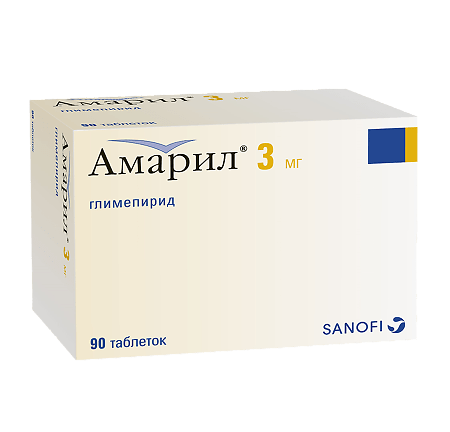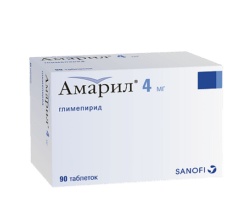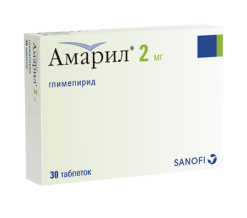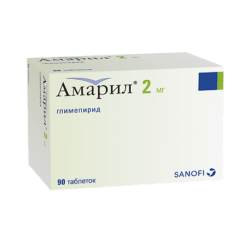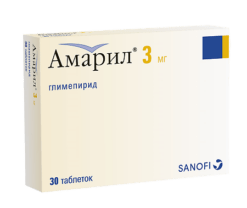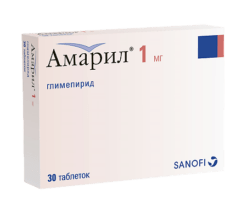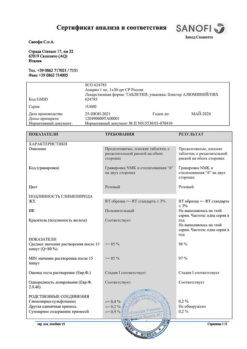No products in the cart.
Amaril, tablets 3 mg 90 pcs
€93.00 €77.50
Description
Pharmacodynamics
The oral hypoglycemic drug is a sulfonylurea derivative of III generation.
Glimepiride reduces blood glucose concentration, mainly due to stimulation of insulin release from the pancreatic β-cells. Its effect is mainly due to an improvement in the ability of pancreatic β-cells to respond to physiological glucose stimulation. Compared to glibenclamide, glimepiride at low doses causes the release of less insulin while achieving approximately the same decrease in blood glucose concentration. This fact is evidence in favor of the presence of extrapancreatic hypoglycemic effects of glimepiride (increased tissue sensitivity to insulin and insulinomimetic effect).
Insulin secretion. Like all other sulfonylurea derivatives, glimepiride regulates insulin secretion by interaction with ATP-sensitive potassium channels on β-cell membranes. Unlike other sulfonylurea derivatives, glimepiride selectively binds to a protein with a molecular weight of 65 kilodaltons located in the membranes of pancreatic β-cells. This interaction of glimepiride with the protein that binds to it regulates the opening or closing of ATP-sensitive potassium channels.
Glimepiride closes potassium channels. This causes depolarization of β-cells and leads to the opening of voltage-sensitive calcium channels and the entry of calcium into the cell. As a result, increased intracellular calcium concentration activates insulin secretion by exocytosis.
Glimepiride binds to and is released from its binding protein much faster and correspondingly more frequently than glibenclamide. It is assumed that this property of glimepiride’s high rate of exchange with its binding protein accounts for its pronounced effect of sensitizing β-cells to glucose and protecting them from desensitization and premature depletion.
The effect of increasing tissue sensitivity to insulin. Glimepiride enhances the effects of insulin on glucose uptake by peripheral tissues.
The insulinomimetic effect. Glimepiride has effects similar to those of insulin on glucose uptake by peripheral tissues and glucose output from the liver.
The uptake of glucose by peripheral tissues is through its transport inside muscle cells and adipocytes. Glimepiride directly increases the number of glucose transporting molecules in the plasma membranes of muscle cells and adipocytes. Increased intracellular glucose entry leads to activation of glycosylphosphatidylinositol-specific phospholipase C. As a result, intracellular calcium concentration decreases, causing a decrease in protein kinase A activity, which in turn leads to stimulation of glucose metabolism.
Glimepiride inhibits glucose output from the liver by increasing the concentration of fructose-2,6-bisphosphate, which inhibits gluconeogenesis.
The effect on platelet aggregation. Glimepiride reduces platelet aggregation in vitro and in vivo. This effect seems to be connected with selective inhibition of COX, which is responsible for formation of thromboxane A, an important endogenous factor of platelet aggregation. Antiatherogenic action. Glimepiride promotes normalization of lipids, reduces the level of malonic aldehyde in blood, which leads to a significant reduction in lipid peroxidation. In animals glimepiride leads to a significant reduction of atherosclerotic plaque formation.
The severity of oxidative stress, which is constantly present in patients with type 2 diabetes, is reduced. Glimepiride increases the level of endogenous α-tocopherol, catalase activity, glutathione peroxidase and superoxide dismutase.
Cardiovascular effects. Through ATP-sensitive potassium channels, sulfonylurea derivatives also have effects on the cardiovascular system. Compared with traditional sulfonylurea derivatives, glimepiride has significantly less effect on the cardiovascular system, which may be explained by the specific nature of its interaction with the ATP-sensitive potassium channel protein that binds to it.
In healthy volunteers, the minimum effective dose of glimepiride is 0.6 mg. The effect of glimepiride is dose-dependent and reproducible. Physiological response to physical activity (decreased insulin secretion) is maintained while taking glimepiride.
There are no significant differences in the effect depending on whether the drug was taken 30 minutes before a meal or immediately before a meal. In patients with diabetes mellitus it is possible to achieve sufficient metabolic control within 24 h with a single dose of the drug. Moreover, in a clinical trial, sufficient metabolic control was also achieved in 12 of 16 patients with renal impairment (KC 4-79 ml/min).
Combination therapy with metformin. In patients with insufficient metabolic control at the maximum dose of glimepiride, combination therapy with glimepiride and metformin may be initiated. Two studies have shown an improvement in metabolic control with combination therapy compared with treatment with each of these drugs alone.
Combination therapy with insulin. In patients with insufficient metabolic control, concomitant therapy with insulin may be initiated while taking glimepiride at maximum doses. According to the results of two studies, this combination achieves the same improvement in metabolic control as the use of insulin alone. However, a lower dose of insulin is required with combination therapy.
Pharmacokinetics
When comparing data obtained with single and multiple (once daily) administration of glimepiride, no significant differences in pharmacokinetic parameters were found, and their variability between different patients was very low. There was no significant accumulation of the drug.
Intake
When multiple oral doses of the drug at a daily dose of 4 mg, Cmax in blood serum is reached after approximately 2.5 hours and is 309 ng/ml. There is a linear relationship between the dose and Cmax of glimepiride in blood plasma, as well as between the dose and AUC. The bioavailability of glimepiride is 100% when administered orally. Food intake has no significant effect on absorption, except for a slight delay in its rate.
Distribution
Glimepiride is characterized by a very low Vd (about 8.8 L), approximately equal to the Vd of albumin, high plasma protein binding (over 99%) and low clearance (about 48 ml/min).
Glimepiride is excreted with breast milk and crosses the placental barrier.
Metabolism
Glimepiride is metabolized in the liver (mainly with the participation of CYP2C9 isoenzyme) to form 2 metabolites – hydroxylated and carboxylated derivatives, which are found in urine and stool.
The T1/2 at plasma concentrations of the drug in the serum, corresponding to the multiple dosing regimen, is approximately 5-8 hours. After glimepiride administration in high doses, the T1/2 is slightly increased. After a single oral dose, 58% of glimepiride is excreted by the kidneys and 35% by the intestine. The unchanged active substance is not detected in the urine.
The T1/2 of hydroxylated and carboxylated glimepiride metabolites were about 3-5 h and 5-6 h, respectively.
Pharmacokinetics in special clinical cases
Pharmacokinetic parameters are similar in patients of different sex and different age groups.
In patients with impaired renal function (with low CK), there is a tendency for glimepiride clearance to increase and for its average serum concentrations to decrease, which is likely due to the faster excretion of the drug due to its lower protein binding. Thus, there is no additional risk of glimepiride cumulation in this category of patients.
Indications
Indications
Type 2 diabetes mellitus (as monotherapy or as part of combination therapy with metformin or insulin).
Pharmacological effect
Pharmacological effect
Pharmacodynamics
An oral hypoglycemic drug is a third generation sulfonylurea derivative.
Glimepiride reduces blood glucose concentrations, mainly by stimulating the release of insulin from pancreatic β-cells. Its effect is primarily associated with improving the ability of pancreatic β-cells to respond to physiological stimulation with glucose. Compared with glibenclamide, low doses of glimepiride cause the release of less insulin while achieving approximately the same reduction in blood glucose concentrations. This fact indicates that glimepiride has extrapancreatic hypoglycemic effects (increased tissue sensitivity to insulin and insulinomimetic effect).
Insulin secretion. Like all other sulfonylureas, glimepiride regulates insulin secretion through interaction with ATP-sensitive potassium channels on β-cell membranes. Unlike other sulfonylurea derivatives, glimepiride selectively binds to a protein with a molecular weight of 65 kilodaltons located in the membranes of pancreatic β-cells. This interaction of glimepiride with its binding protein regulates the opening or closing of ATP-sensitive potassium channels.
Glimepiride closes potassium channels. This causes depolarization of β-cells and leads to the opening of voltage-sensitive calcium channels and the entry of calcium into the cell. As a result, an increase in intracellular calcium concentration activates insulin secretion through exocytosis.
Glimepiride binds and is released from the binding protein much faster and, accordingly, more often than glibenclamide. It is assumed that this property of the high rate of exchange of glimepiride with the protein that binds to it determines its pronounced effect of sensitization of β-cells to glucose and their protection from desensitization and premature exhaustion.
The effect of increasing tissue sensitivity to insulin. Glimepiride enhances the effects of insulin on glucose uptake by peripheral tissues.
Insulinomimetic effect. Glimepiride has effects similar to those of insulin on glucose uptake into peripheral tissues and glucose output from the liver.
Glucose is absorbed by peripheral tissues by transporting it into muscle cells and adipocytes. Glimepiride directly increases the number of glucose transport molecules in the plasma membranes of muscle cells and adipocytes. An increase in the entry of glucose into cells leads to the activation of glycosylphosphatidylinositol-specific phospholipase C. As a result, the intracellular calcium concentration decreases, causing a decrease in the activity of protein kinase A, which in turn leads to stimulation of glucose metabolism.
Glimepiride inhibits the release of glucose from the liver by increasing the concentration of fructose-2,6-bisphosphate, which inhibits gluconeogenesis.
Effect on platelet aggregation. Glimepiride reduces platelet aggregation in vitro and in vivo. This effect appears to be due to selective inhibition of COX, which is responsible for the formation of thromboxane A, an important endogenous platelet aggregation factor. Antiatherogenic effect. Glimepiride helps normalize lipid levels, reduces the level of malonaldehyde in the blood, which leads to a significant reduction in lipid peroxidation. In animals, glimepiride leads to a significant reduction in the formation of atherosclerotic plaques.
Reducing the severity of oxidative stress, which is constantly present in patients with type 2 diabetes. Glimepiride increases the level of endogenous α-tocopherol, the activity of catalase, glutathione peroxidase and superoxide dismutase.
Cardiovascular effects. Sulfonylureas also have effects on the cardiovascular system through ATP-sensitive potassium channels. Compared with traditional sulfonylurea derivatives, glimepiride has a significantly lesser effect on the cardiovascular system, which may be explained by the specific nature of its interaction with the ATP-sensitive potassium channel protein that binds to it.
In healthy volunteers, the minimum effective dose of glimepiride is 0.6 mg. The effect of glimepiride is dose-dependent and reproducible. The physiological response to physical activity (decreased insulin secretion) is preserved when taking glimepiride.
There are no significant differences in the effect depending on whether the drug was taken 30 minutes before meals or immediately before meals. In patients with diabetes mellitus, sufficient metabolic control can be achieved within 24 hours with a single dose of the drug. Moreover, in a clinical study, 12 of 16 patients with renal failure (creatinine clearance 4-79 ml/min) also achieved sufficient metabolic control.
Combination therapy with metformin. In patients with insufficient metabolic control when using the maximum dose of glimepiride, combination therapy with glimepiride and metformin may be initiated. Two studies demonstrated improved metabolic control with combination therapy compared with either drug alone.
Combination therapy with insulin. In patients with insufficient metabolic control while taking maximum doses of glimepiride, concomitant insulin therapy may be initiated. Two studies found that this combination achieved the same improvement in metabolic control as insulin alone. However, combination therapy requires a lower dose of insulin.
Pharmacokinetics
When comparing data obtained with single and multiple (1 time/day) administration of glimepiride, no significant differences in pharmacokinetic parameters were revealed, and their variability between different patients was very low. There is no significant accumulation of the drug.
Suction
With repeated oral administration of the drug at a daily dose of 4 mg, Cmax in the blood serum is achieved in approximately 2.5 hours and is 309 ng/ml. There is a linear relationship between dose and Cmax of glimepiride in plasma, as well as between dose and AUC. When taken orally, the bioavailability of glimepiride is 100%. Food intake does not have a significant effect on absorption, except for a slight slowdown in its rate.
Distribution
Glimepiride is characterized by a very low Vd (about 8.8 l), approximately equal to the Vd of albumin, a high degree of binding to plasma proteins (more than 99%) and low clearance (about 48 ml/min).
Glimepiride is excreted in breast milk and penetrates the placental barrier.
Metabolism
Glimepiride is metabolized in the liver (mainly with the participation of the CYP2C9 isoenzyme) with the formation of 2 metabolites – hydroxylated and carboxylated derivatives, which are found in urine and feces.
Removal
T1/2 at plasma concentrations of the drug in serum corresponding to multiple dosing regimens is approximately 5-8 hours. After taking glimepiride in high doses, T1/2 increases slightly. After a single oral dose, 58% of glimepiride is excreted by the kidneys and 35% through the intestines. Unchanged active substance is not detected in urine.
T1/2 of the hydroxylated and carboxylated metabolites of glimepiride were about 3-5 hours and 5-6 hours, respectively.
Pharmacokinetics in special clinical situations
Pharmacokinetic parameters are similar in patients of different sexes and different age groups.
In patients with impaired renal function (with low creatinine clearance), there is a tendency for the clearance of glimepiride to increase and for its mean serum concentrations to decrease, which is likely due to more rapid elimination of the drug due to its lower protein binding. Thus, in this category of patients there is no additional risk of accumulation of glimepiride.
Special instructions
Special instructions
In specific clinical stress conditions, such as trauma, surgery, infections, and febrile fever, metabolic control may deteriorate in patients with diabetes, so temporary switching to insulin therapy may be necessary to maintain adequate metabolic control.
In the first weeks of treatment, the risk of developing hypoglycemia may increase, which requires particularly careful monitoring of blood glucose concentrations.
Factors that contribute to the risk of developing hypoglycemia include:
the patient’s reluctance or inability (more often observed in elderly patients) to cooperate with the doctor;
malnutrition, irregular eating or skipping meals;
imbalance between physical activity and carbohydrate consumption;
diet change;
drinking alcohol, especially in combination with skipping meals;
severe renal dysfunction;
severe liver dysfunction (in patients with severe liver dysfunction, transfer to insulin therapy is indicated, at least until metabolic control is achieved);
overdose of glimepiride;
some decompensated endocrine disorders that impair carbohydrate metabolism or adrenergic counterregulation in response to hypoglycemia (for example, some disorders of the thyroid gland and anterior pituitary gland, adrenal insufficiency);
simultaneous use of certain medications;
taking glimepiride in the absence of indications for its use.
Treatment with sulfonylurea derivatives, which include glimepiride, can lead to the development of hemolytic anemia, therefore, in patients with glucose-6-phosphate dehydrogenase deficiency, special care should be taken when prescribing glimepiride; it is preferable to use hypoglycemic agents that are not sulfonylurea derivatives.
If the above risk factors for hypoglycemia are present, as well as if intercurrent diseases occur during treatment or changes in the patient’s lifestyle, adjustment of the dose of glimepiride or the entire therapy may be necessary.
Symptoms of hypoglycemia, resulting from adrenergic counterregulation of the body in response to hypoglycemia, may be mild or absent when hypoglycemia develops gradually, in elderly patients, in patients with disorders of the autonomic nervous system, or in patients receiving beta-blockers, clonidine, reserpine, guanethidine and other sympatholytic agents.
Hypoglycemia can be quickly corrected by immediate administration of rapidly digestible carbohydrates (glucose or sucrose). As with other sulfonylureas, despite initial successful relief of hypoglycemia, hypoglycemia may recur. Therefore, patients should remain under constant monitoring. Severe hypoglycemia additionally requires immediate treatment and medical supervision, and in some cases, hospitalization of the patient.
During treatment with glimepiride, regular monitoring of liver function and peripheral blood patterns (especially the number of leukocytes and platelets) is required.
Side effects such as severe hypoglycemia, serious changes in blood count, severe allergic reactions, liver failure can be life-threatening, therefore, if such reactions develop, the patient should immediately inform the attending physician about them, stop taking the drug and not resume taking it without a doctor’s recommendation.
Use in pediatrics
There are no data on the long-term effectiveness and safety of the drug in children.
Impact on the ability to drive vehicles and other mechanisms that require increased concentration
At the beginning of treatment, after changing treatment, or when taking glimepiride irregularly, a decrease in concentration and speed of psychomotor reactions due to hypo- or hyperglycemia may be observed. This may adversely affect the ability to drive vehicles or operate various machines and mechanisms.
Active ingredient
Active ingredient
Glimepiride
Composition
Composition
Active ingredients:
glimepiride 3 mg.
Excipients:
lactose monohydrate,
sodium carboxymethyl starch (type A),
povidone 25,000,
microcrystalline cellulose,
magnesium stearate,
iron oxide yellow dye (E172).
Pregnancy
Pregnancy
Amaryl® is contraindicated for use during pregnancy. In case of planned pregnancy or if pregnancy occurs, the woman should be transferred to insulin therapy.
It has been established that glimepiride is excreted in breast milk. During lactation, the woman should be switched to insulin or breastfeeding should be stopped.
Contraindications
Contraindications
Diabetes mellitus type 1;
diabetic ketoacidosis, diabetic precoma and coma;
severe liver dysfunction (lack of clinical experience);
severe renal dysfunction, incl. patients on hemodialysis (lack of clinical experience);
pregnancy;
lactation (breastfeeding);
children’s age (lack of clinical experience);
rare hereditary diseases such as galactose intolerance, lactase deficiency or glucose-galactose malabsorption;
hypersensitivity to the components of the drug;
hypersensitivity to other sulfonylurea derivatives and sulfonamide drugs (risk of developing hypersensitivity reactions).
With caution: the drug should be used in the first weeks of treatment (increased risk of hypoglycemia); if there are risk factors for the development of hypoglycemia (adjustment of the dose of glimepiride or the entire therapy may be required); for intercurrent diseases during treatment or when changing the lifestyle of patients (changing diet and meal times, increasing or decreasing physical activity); with glucose-6-phosphate dehydrogenase deficiency; in cases of impaired absorption of food and drugs from the gastrointestinal tract (intestinal obstruction, intestinal paresis).
Side Effects
Side Effects
Metabolic: hypoglycemia is possible, which, as with the use of other sulfonylurea derivatives, can be prolonged. Symptoms of hypoglycemia – headache, hunger, nausea, vomiting, feeling tired, drowsiness, sleep disturbances, anxiety, aggressiveness, impaired concentration, vigilance and reaction speed, depression, confusion, speech disorders, aphasia, visual disturbances, tremors, paresis, sensory disturbances, dizziness, loss of self-control, delirium, cerebral spasms, drowsiness or loss of consciousness up to coma, shallow breathing, bradycardia. In addition, manifestations of adrenergic counterregulation in response to hypoglycemia may occur, such as the appearance of cold clammy sweat, anxiety, tachycardia, hypertension, angina, palpitations and cardiac arrhythmias. The clinical picture of severe hypoglycemia may resemble a stroke. Symptoms of hypoglycemia almost always disappear once it is corrected.
On the part of the organ of vision: transient visual impairment is possible (especially at the beginning of treatment), caused by changes in the concentration of glucose in the blood. Their cause is a temporary change in the swelling of the lenses, depending on the concentration of glucose in the blood, and due to this change in the refractive index of the lenses.
From the digestive system: rarely – nausea, vomiting, feeling of heaviness or fullness in the epigastrium, abdominal pain, diarrhea; in some cases – hepatitis, increased activity of liver enzymes and/or cholestasis and jaundice, which can progress to life-threatening liver failure, but may reverse when the drug is discontinued.
From the hematopoietic system: rarely – thrombocytopenia; in some cases – leukopenia, hemolytic anemia, erythrocytopenia, granulocytopenia, agranulocytosis and pancytopenia. During post-marketing use of the drug, cases of severe thrombocytopenia with platelet counts <10,000/μl and thrombocytopenic purpura have been reported (frequency unknown).
Allergic reactions: rarely – allergic and pseudo-allergic reactions, such as itching, urticaria, skin rash. Such reactions are almost always mild, but can develop into severe reactions with shortness of breath, a sharp decrease in blood pressure, which sometimes progress to anaphylactic shock; in some cases – allergic vasculitis.
Other: in some cases – hyponatremia, photosensitivity.
If symptoms of hives appear, you should consult a doctor immediately.
Interaction
Interaction
Glimepiride is metabolized with the participation of the CYP2C9 isoenzyme, which should be taken into account when using the drug simultaneously with inducers (for example, rifampicin) or inhibitors (for example, fluconazole) of CYP2C9.
Potentiation of the hypoglycemic effect and, in some cases, the associated possible development of hypoglycemia can be observed when Amaryl® is combined with one of the following drugs: insulin, other oral hypoglycemic agents, ACE inhibitors, anabolic steroids and male sex hormones, chloramphenicol, coumarin derivatives, cyclophosphamide, disopyramide, fenfluramine, pheniramidol, fibrates, fluoxetine, guanethidine, ifosfamide, MAO inhibitors, fluconazole, PAS, pentoxifylline (high parenteral doses), phenylbutazone, azapropazone, oxyphenbutazone, probenecid, quinolones, salicylates, sulfinpyrazone, clarithromycin, sulfonamides, tetracyclines, tritoqualine, trophosfamide.
A decrease in the hypoglycemic effect and an associated increase in blood glucose concentration is possible when combined with one of the following drugs: acetazolamide, barbiturates, corticosteroids, diazoxide, diuretics, sympathomimetic agents (including epinephrine), glucagon, laxatives (with long-term use), nicotinic acid (in high doses), estrogens and progestogens, phenothiazines, phenytoin, rifampicin, iodine-containing thyroid hormones.
Histamine H2 receptor blockers, beta-blockers, clonidine and reserpine can both enhance and reduce the hypoglycemic effect of glimepiride.
Under the influence of sympatholytic agents such as beta-blockers, clonidine, guanethidine and reserpine, signs of adrenergic counterregulation in response to hypoglycemia may be reduced or absent.
While taking glimepiride, the effect of coumarin derivatives may be enhanced or weakened.
Single or chronic consumption of alcohol can either enhance or weaken the hypoglycemic effect of glimepiride.
Bile acid sequestrants: Colesevelam binds to glimepiride and reduces the absorption of glimepiride from the gastrointestinal tract. When glimepiride is administered at least 4 hours before oral administration of colesevelam, no interaction is observed. Therefore, glimepiride should be taken at least 4 hours before taking colesevelam.
Overdose
Overdose
Symptoms: in case of acute overdose, as well as long-term treatment with glimepiride in excessively high doses, severe life-threatening hypoglycemia may develop.
Treatment: Hypoglycemia can almost always be quickly reversed by immediate intake of carbohydrates (glucose or a lump of sugar, sweet fruit juice or tea). In this regard, the patient should always have at least 20 g of glucose (4 lumps of sugar) with him. Sweeteners are ineffective in treating hypoglycemia.
Until the doctor decides that the patient is out of danger, the patient requires careful medical observation. It should be borne in mind that hypoglycemia may recur after the initial restoration of blood glucose concentrations.
If a patient suffering from diabetes is treated by different doctors (for example, while staying in the hospital after an accident, when sick on the weekend), he must inform them about his illness and previous treatment.
Sometimes it may be necessary to hospitalize the patient, even if only as a precaution. Significant overdose and severe reactions with manifestations such as loss of consciousness or other serious neurological damage are medical emergencies and require immediate treatment and hospitalization.
In case of loss of consciousness, it is necessary to administer a concentrated solution of dextrose (glucose) intravenously (for adults, starting with 40 ml of a 20% solution). As an alternative, adults can administer glucagon IV, SC or IM, for example at a dose of 0.5-1 mg.
When treating hypoglycemia due to accidental ingestion of Amaryl® in infants or young children, the dextrose dose should be carefully adjusted to avoid the possibility of dangerous hyperglycemia; administration of dextrose should be carried out under constant monitoring of blood glucose concentrations.
In case of an overdose of Amaryl®, gastric lavage and activated charcoal may be required.
After rapid restoration of blood glucose concentrations, it is imperative to carry out an intravenous infusion of a dextrose solution at a lower concentration to prevent the resumption of hypoglycemia. The blood glucose concentration in such patients should be constantly monitored over a 24-hour period. In severe cases with prolonged hypoglycemia, the risk of a decrease in blood glucose levels may persist for several days.
As soon as an overdose is detected, you must immediately inform your doctor.
Storage conditions
Storage conditions
At a temperature not exceeding 30 °C
Shelf life
Shelf life
3 years
Manufacturer
Manufacturer
Sanofi S.R.L., Italy
Additional information
| Shelf life | 3 years |
|---|---|
| Conditions of storage | At a temperature not exceeding 30 °C |
| Manufacturer | Sanofi S.R.L., Italy |
| Medication form | pills |
| Brand | Sanofi S.R.L. |
Other forms…
Related products
Buy Amaril, tablets 3 mg 90 pcs with delivery to USA, UK, Europe and over 120 other countries.

